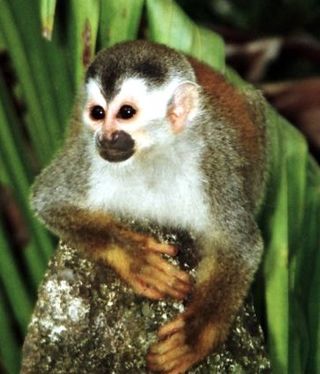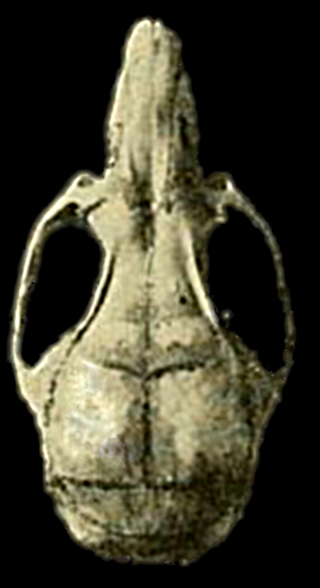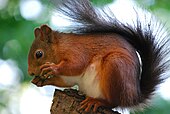
The oncilla, also known as the northern tiger cat, little spotted cat, and tigrillo, is a small spotted cat ranging from Central America to central Brazil. It is listed as Vulnerable on the IUCN Red List, and the population is threatened by deforestation and conversion of habitat to agricultural land.

The Central American squirrel monkey, also known as the red-backed squirrel monkey, is a squirrel monkey species from the Pacific coast of Costa Rica and Panama. It is restricted to the northwestern tip of Panama near the border with Costa Rica, and the central and southern Pacific coast of Costa Rica, primarily in Manuel Antonio and Corcovado National Parks.

The Amazon dwarf squirrel is a chipmunk-sized tree squirrel native to South America.

The Neotropical pygmy squirrel is a South American species of tree squirrel, being the only living species in the genus Sciurillus and the subfamily Sciurillinae. Genetic analysis has shown it to be the sister group to all other squirrels.

Microsciurus or dwarf squirrels is a genus of squirrels from the tropical regions of Central and South America.

The northern olingo, also known as the bushy-tailed olingo or as simply the olingo, is a tree-dwelling member of the family Procyonidae, which also includes raccoons. It was the first species of olingo to be described, and while it is considered by some authors to be the only genuine olingo species, a recent review of the genus Bassaricyon has shown that there are a total of four olingo species, although two of the former species should now be considered as a part of this species. Its scientific name honors William More Gabb, who collected the first specimen. It is native to Central America.

The pygmy fruit-eating bat is a bat of the family Phyllostomidae. The specific name phaeotis is of Greek derivation, coming from the word phaios meaning dusky, referring to their dusky gray coloration.

Transandinomys bolivaris, also known as the long-whiskered rice rat, is a rodent in the family Cricetidae. It is found in humid forest from northeastern Honduras to western Ecuador, up to 1,800 m (5,900 ft) above sea level. Since it was first described in 1901 from Ecuador, six scientific names have been introduced for it, but their common identity was not documented until 1998 and the species has long been known under the name Oryzomys bombycinus, described from Panama in 1912. The name Oryzomys bolivaris was used before it was moved to the new genus Transandinomys with Transandinomys talamancae in 2006.
Sigmodontomys alfari, also known as the short-tailed sigmodontomys, Alfaro's rice water rat, Cana rice rat, or Allen's rice rat, is a species of rodent in the subfamily Sigmodontinae of family Cricetidae. It is found from Honduras through Nicaragua, Costa Rica, and Panama into South America, where it occurs from Venezuela through Colombia to Ecuador.

The Central American pygmy owl is a species of owl in the family Strigidae. It is found in Belize, Colombia, Costa Rica, Ecuador, Guatemala, Honduras, Mexico, Nicaragua, and Panama.

The western dwarf squirrel is a small tree squirrel in the genus Microsciurus and tribe Sciurini found in Colombia, Ecuador, and Panama.

The Santander dwarf squirrel is a small tree squirrel endemic to Colombia.

The red-tailed squirrel is a species of tree squirrel distributed from southern Central America to northern South America.

The variegated squirrel is a tree squirrel in the genus Sciurus found in Costa Rica, El Salvador, Guatemala, Honduras, southern Mexico, Nicaragua, and Panama. Fifteen subspecies are recognised. It is a common squirrel and the International Union for Conservation of Nature has rated it a "least-concern species". Variegated squirrels kept as pets in Germany have been implicated in the transmission of a bornavirus to humans from which three people have died.

The black-crowned Central American squirrel monkey is a subspecies of the Central American squirrel monkey. Its range is restricted to the Pacific coast of western Panama to the western portion of the Chiriquí Province and of southern Costa Rica, south of the Rio Grande de Terraba, including the Osa Peninsula. It is the subspecies of Central American squirrel monkey seen in Corcovado National Park in Costa Rica. Its type locality is David, Panama, but its range apparently no longer extends that far east.

















